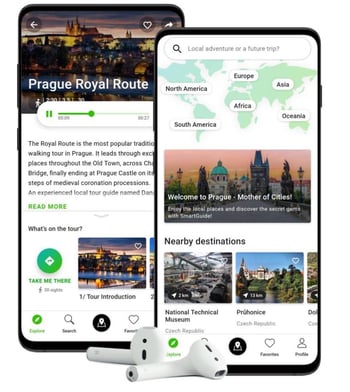In today's changing world of tourism, it's important to adapt and embrace technology to stay...
TTS audio vs. TTS with phonemes vs. human audio in digital audio guides
For digital audio guides, the audible content is as significant as the visual and text content. The choice of audio track used - whether it's Text-to-Speech (TTS), TTS with phonemes, or human audio - can singlehandedly change the entire user experience. It's important for content authors to understand the differences among these audio options and their distinct attributes.

A tourist enjoying the destination using Text-to-Speech (TTS) audio on SmartGuide app
SmartGuide, the world's #1 digital audio guide platform, offers all three above-mentioned options for audio tracks in its digital audio guides.
The first option, TTS audio, leverages the AI-powered process of converting written text into spoken words.
The second, TTS with phonemes, not only translates text into audio but also carefully rectifies the pronunciation of phonemes by specifically trained AI models.
Lastly, the Human audio option utilizes professional voice actors to provide an authentic, human touch to the audio guides.
These advanced technologies have brought significant advancements to the creation of flexible and convenient digital audio guides, delivering machine-generated audio quality that closely resembles human speech in a matter of milliseconds.

Explore SmartGuide, the world's #1 digital audio guide that offers a trio of audio track choices
Enhancing user experience with TTS - benefits and drawbacks
TTS (text-to-speech) is a technology that converts written text into spoken words. This technology enables the creation of engaging digital audio guides that aim to deliver highly accurate and natural-sounding audio. It has gained increasing popularity with museums, expositions, theme parks, and other attractions as it offers many advantages over conventional means.
Benefits of TTS audio:
- More efficient and cost-effective than recording human voices.
- Can be used to create multiple versions of digital audio guides in different languages, without the need for additional recording sessions.
- Advancements in AI technology allow for more natural-sounding TTS voices.
- Offers a variety of voices and languages for a personalized experience, thereby catering to a wider audience size.
Drawbacks of TTS audio:
- Lower-quality audio compared to professional human voices.
- Speech can sound monotonous, and mistakes may be more noticeable than with a human voice.
- Can lack the richness, nuance, and natural cadence that human voices possess.
- No guarantee as to the accuracy of the pronunciation or intonation in different languages when pronounced in another language (e.g. German names are pronounced with English pronunciation if the output is in English).
- Reading the text literally can sometimes lead to unnatural-sounding outcomes, particularly when dealing with abbreviations and names.
An audio sample of TTS audio
TTS enables a fast and extremely affordable generation of audio tracks used in digital travel guides. It's the go-to option for creating multilingual guides on scale and reduces the need to search for expensive voice actors.
However, despite it keeps improving fast, TTS audio quality is typically lower than human audio. This can be partially reduced by training the TTS AI to sound more natural by teaching it to recognize and pronounce specific phonemes - distinct units of sound in a specified language.
Fixing raw TTS audio outputs with phonemes
TTS (Text-to-Speech) with fixed phonemes is a powerful combination for generating digital audio guides, offering improved pronunciation accuracy and naturalness of speech compared to basic TTS. At SmartGuide, we automatically convert text into audio and we also offer a paid service where we meticulously train our AI-powered TTS models to ensure 100% correct pronunciation in several languages.
Benefits of TTS audio with phonemes:- TTS audio with phonemes offers improved pronunciation accuracy over basic TTS audio, leading to more natural and fluent speech delivery.
- The cost is still very affordable and significantly lower compared to hiring voice actors
- It allows for a more inclusive user experience, catering to people who speak different languages or have different accents.
- The technology is constantly evolving, with the quality of TTS audio significantly improving over time.
- TTS audio, even with phonemes, still cannot convey emotion as effectively as a human voice, potentially compromising the user experience.
- There is no guarantee of accurate pronunciation in all languages. The success of TTS with phonemes heavily depends on the quality of the pronunciation dictionary and the rules used for conversion, which may not always be 100% reliable or accurate in certain languages.
- At SmartGuide, TTS with phonemes is a paid service, which may not be affordable for all guide content authors or in all scenarios.
An audio sample of TTS audio with phonemes
Despite the mentioned drawbacks, the enhanced pronunciation accuracy, cost-efficiency, and inclusivity offered by TTS with phonemes make it a valuable tool in the creation of digital audio guides.
Human audio is still a sought-after choice in audio guide creation
When it comes to digital audio guides, human audio is still the most preferred choice by travelers as well as destinations and tourist attractions such as museums. A professional voice actor adds a personal touch to the user experience in ways that TTS audio and TTS audio with phonemes cannot. It offers an impeccable quality of speech, with all of its nuances and inflections, enriching the audio guide experience. But, it comes with a high prices tag and slower delivery.
Benefits of human audio:
- Human audio brings a personal touch and a natural flow of speech, allowing for a more engaging experience.
- Humans can ensure accurate pronunciations, avoiding any misinterpretations.
- With human audio, there is a variety of voices to choose from, adding diversity to the audio guide.
- Producing human audio guides takes time due to the lengthy recording and editing process.
- Hiring voice talent and managing the production of human audio can be demanding and expensive.
- With human audio, making changes to the content can be challenging and may require re-recording.
- Switching between languages or voices can be complicated and requires coordination with different speakers.
- Once human audio is published, making edits or updates can be impractical.
An audio sample of the human voice
Human audio offers a rich and engaging listening experience, despite challenges like higher costs, longer production times, and content update difficulties. Yet, it still remains irreplaceable if personal touch, nuanced expression, and specific pronunciation are essential. As the demand for immersive experiences grows, consider the unique advantages and constraints of human audio in developing digital audio guides.
Wrap-up
No matter which technology you choose to use in creating a digital audio guide – TTS audio, TTS audio with phonemes, or human audio – it is important to make an informed decision that best suits your needs.
You should consider the budget, timeline, language requirements, availability of resources, and desired user experience when deciding which technology to use.
At SmartGuide, our experts can help you make the right choice for your project. We have extensive experience in creating digital audio guides and have worked with quality multilingual voice talent to develop content that is engaging and informative.
Contact us today for more information on our services. Happy listening!
.png?width=300&height=69&name=Logo%20SmartGuide%20horizontal%20(1).png)


